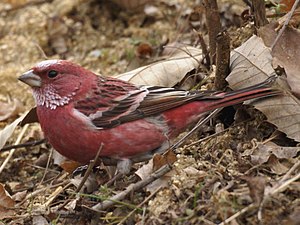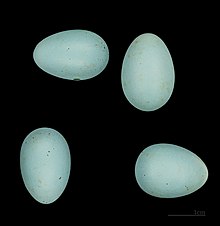Rose pennant
| Rose pennant | ||||||||||||
|---|---|---|---|---|---|---|---|---|---|---|---|---|

Male of the rose beak ( Carpodacus roseus ) |
||||||||||||
| Systematics | ||||||||||||
|
||||||||||||
| Scientific name | ||||||||||||
| Carpodacus roseus | ||||||||||||
| ( Pallas , 1776) |
The rose groin ( Carpodacus roseus ) is a songbird from the finch family . It predominantly inhabits wooded mountain regions of the taiga in southern central Siberia. The northern and middle populations move to more southern areas in winter.
description
Appearance
With a body length of 16–17 cm, the rose groin belongs to the medium-sized carmine species . The bird looks rather stocky, the tail comparatively long in flight. The wing length of the male is 82–93 mm, that of the female 80–91.5 mm. The tail length is between 61 and 74 mm, the weight between 21 and 35 g. The beak is short and strong with a fine tip. The feet are reddish brown. Subspecies are not described.
The sexes differ significantly in the color of the plumage. The male's head, neck and almost the entire underside are dark pink. The crown and throat show conspicuous, white tips. On the back of the abdomen, the pink color fades into whitish. The upper back is gray-brown and becomes dark pink towards the rear with dark, broad feathers. The lower back and the upper tail-coverts are colored pink. The forked joint is black-brown with pink or pale pink edges. The edge covers are dark pink, the arm covers are dark brown with pink hems and light tips that form a double, light band of wings. The wings and hand covers are dark brown with a lighter or pink border. In winter, the contrast between the white tips of the feathers and the dark pink of the face is not so pronounced; the bird looks more brownish overall.
The female is predominantly gray-brown with dark stripes. The face, throat and chest are tinged with red. This color changes to a reddish orange on the stomach. The rump is pink to pinkish-orange. Males in the first year are similar to females, but the reddish areas are less strong. Females in the first year are even less colored.
voice
The species is not very popular. The call is a short, muffled whistle. The singing, which is not very far-reaching, sounds similar, with sequences of calls with ascending and descending tones being repeated as stanzas at intervals. It is carried out from elevated waiting areas under the cover of trees.
distribution
The rose groin occurs in southern central Siberia. The occurrence extends from the Yenisei Basin and the southeast Altai northeast through the Lena Basin and east to the Kolyma and the Sea of Okhotsk . In the south, the distribution extends to the Sajan Mountains , to Tannu-Ola , in the Great Hinggan and Chentii Mountains and northwest through the Stanowoy Mountains and the northern Amur region to Sakhalin .
The species is only common in places and otherwise rare. Due to the large distribution area and the apparently constant population trend, the species is regarded as harmless.
habitat
The Rosengimpel inhabits coniferous and birch forests of the northern taiga up to 3030 m above sea level. But you can also find it on alpine meadows, in dense bushes and on barren mountain slopes and peaks. In winter you can find it in the deciduous forest and in bushes in river valleys, sometimes also in the cultural landscape or in settlement habitats.
hikes
The rose grouse is a migratory or line bird. The northern and central populations migrate to more southern or southeastern regions from October to November. The wintering areas are in the Ussuri , southeastern Mongolia and northern China from Gānsù and Shaanxi to Manchuria and south to Jiangsu . The species is less common in Japan , western Siberia and northern Kazakhstan . The withdrawal occurs in March and April. Occasional wanderers in Europe can also be refugees from prison.
Way of life
He usually lives in pairs or in small groups. Swarms of up to 100 specimens form on the train. It feeds on seeds, shoots and buds as well as berries and is therefore mostly found in trees, bushes or on the ground when foraging.
literature
- P. Clement, A. Harris, J. Davis: Finches and Sparrows , Helm Identification Guides, London 1993/1999, ISBN 0-7136-5203-9
Web links
- Carpodacus roseus in the endangered Red List species the IUCN 2009. Posted by: BirdLife International, 2009. Accessed on March 3 of 2010.
- Videos, photos and sound recordings of Carpodacus roseus in the Internet Bird Collection
- Photos of Carpodacus roseus in the Oriental Bird Club image database , accessed on March 3, 2010
- Feathers of the rose elf
